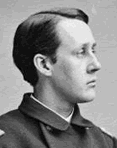 Open main menu
Open main menu
 Open main menu
Open main menu

GENERAL HOSPITAL,
Keedysville, Md., September 22, 1862.
Captain GEORGE H. CALDWELL,
Captain and Asst. Adjt. General, Caldwell's Brigade,
CAPTAIN: I have the honor to make the following report of the operations of the Sixty-first and Sixty-fourth New York Volunteers in the battle of September 17 instant. Both these regiments were under my command on that day and had been for some time previous.
On going into action our brigade was formed on the left of the Irish Brigade, my regiments being the right of the brigade. We remained about fifteen minutes under the fire of the enemy's sharpshooters, which my sharpshooters returned with effect. I lost then Captain Angell and one or two men killed. By order of the staff officer of General Richardson, we then moved to the right in front, and formed behind the crest of a hill on the left of the Sixty-third Regiment, Irish Brigade, who were there briskly engaging the enemy. My regiments at once advanced over the crest of the hill, and bravely engaged the enemy and fired destructively. With the assistance of the fire of the regiments on our right and left, we broke the enemy on our front, who fled in disorder through a corn-field, suffering severely from the fire of our and the Irish Brigade.
The portion of the enemy's line which was not broken then remained lying in a deep road, well protected from a fire in their front. Our position giving us peculiar advantages for attacking in flank this part of the enemy's line, my regiments advanced and obtained an enfilading fire upon the enemy in the aforesaid road. Seeing the uselessness of further resistance, the enemy, in accordance with our demands, threw down their arms, came in in large numbers, and surrendered. Upward of 300 prisoners thus taken by my regiments were sent to the rear with a guard of my regiment, under charge of Lieutenant Alvord, of General Caldwell's staff.
On this occasion my own regiment, the Sixty-first New York, took two of the enemy's battle-flags, which have been forwarded to corps headquarters. A third flag was captured by the Sixty-forth New York Volunteers, which was lost by the subsequent shooting of the captor when away from his regiment. After these events my regiments, with the rest of our line, advanced into the corn-field through which the enemy had fled, beyond the deep road above referred to. No enemy appeared in this field. Our troops were joined together without much order - several regiments in front of others, and none in my neighborhood having very favorable opportunities to use their fire. Seeing quite a body of the enemy moving briskly on the right of our line, at no great distance, to attack us on the flank, my regiments changed front and moved to the crest of a hill on our right flank, occupying the only position where I found we could use our fire to advantage. This was to the right of the Fifty-second New York Volunteers, of Colonel Brooke's brigade. We engaged several regiments of the enemy with effect, some being posted on the edge of a corn-field, behind a stone wall surmounted by a fence; others were posted still farther to the right, on the edge of the corn-field. The enemy at length retreated quite precipitately under the fire of the troops on our side, together with another body of Federal troops, which attacked the enemy in turn on their flank and rear. I am unable to state who these last-named troops were. On retiring from this position, the enemy renewed their attack on our old front. My regiments again changed front, and advanced into the corn-field which we had left, to assist in repelling the flank attack of the enemy just mentioned. Beyond this corn-field was an orchard, in which the enemy had artillery (two pieces to the best of my knowledge). From these pieces, and from others still farther to our right, they had been pouring a destructive fire of shell, grape, and spherical-case shot during the above-mentioned engagement of our infantry.
After thus forming our line on the right of the Fifty-seventh New York Volunteers, of Colonel Brooke's brigade, I was wounded in the groin by a ball from a spherical-case shot and know nothing of what subsequently occurred. For these occurrences, and for list of casualties, I respectfully refer to the report of Lieutenant-Colonel Miles, Sixty-first New York Volunteers, who immediately assumed command of my two regiments.
My own regiment, the Sixty-first New York Volunteers, behaved with the same fortitude and heroism, and showed the same perfect discipline and obedience to orders under trying circumstance, for which I have before commended them, and which causes me to think of them with the deepest affection and admiration. The Sixty-fourth New York Volunteers behaved steadily and bravely.
Of the officers in my own regiment I commend to special notice, for bravery, coolness, and every soldierly quality in action, Captain Walter H. Maze, Company A; First Lieutenant Willard Keech, Company G; Second Lieutenant Theodore W. Greig, Company C; Second Lieutenant Frederick W. Grannis, Company B. Lieutenant Colonel Nelson A. Miles, Sixty-first New York Volunteers, has been distinguished for his admirable conduct in many battles. The voice of every one who saw him in this action will commend better than I can his courage, his quickness, his skill in seeing favorable positions, and the power of his determined spirit in leading on and inspiring the men.
I have the honor to be, captain, your very obedient servant,
FRANCIS C. BARLOW,
Colonel 61st N. Y. Vols., and Commanding 64th N. Y. Vols.
Source: OFFICIAL RECORDS: Series 1, Vol 19, Part 1 (Antietam - Serial 27) , Pages 289 - 290